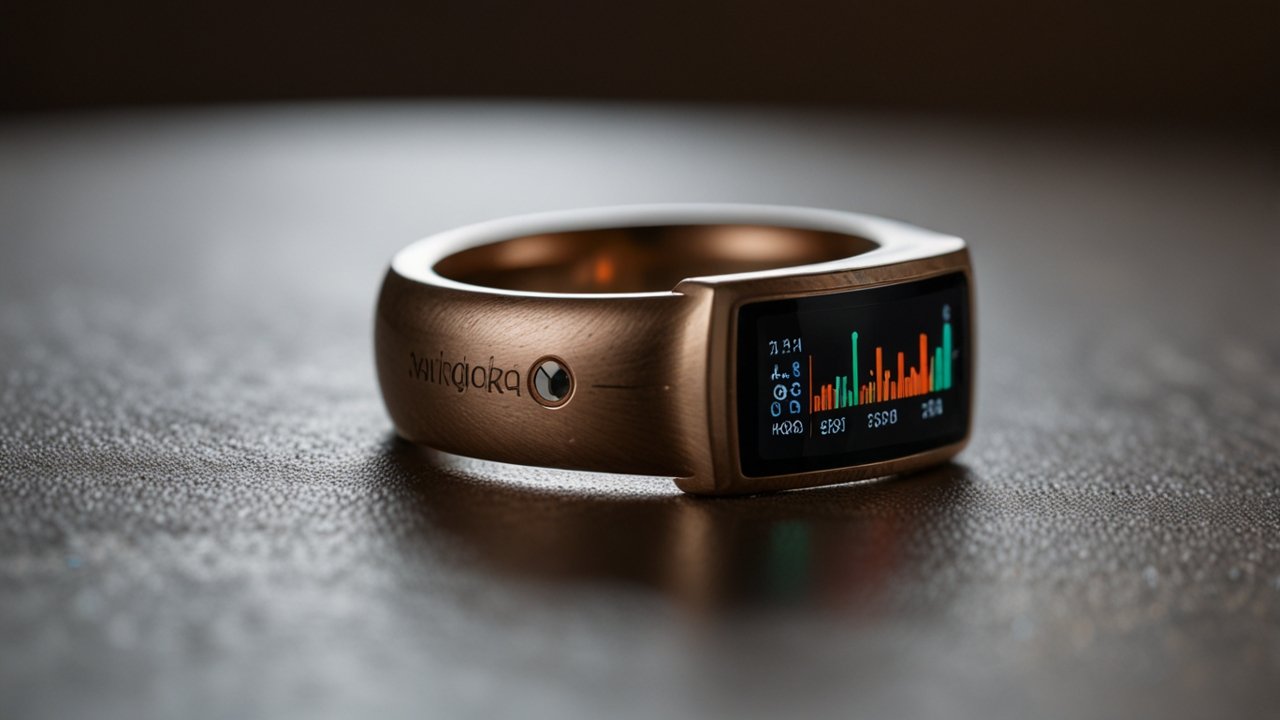Smart Ring Innovation 2025
Welcome to our in‐depth exploration of the revolutionary world of smart rings in 2025. In this article, we will dive into the fascinating evolution, state‐of‐the‐art technologies, and future trends that define this breakthrough in wearable devices. Our discussion is designed for enthusiasts, tech professionals, and anyone curious about the advances in wearable technology that are changing how we track our health.
Smart rings have evolved from basic activity trackers into sophisticated devices that can monitor everything from sleep patterns to non‐invasive blood glucose levels. We will explain the technical jargon in simple language to help you fully appreciate these innovations. Get ready to discover how a compact, ring‐shaped device is redefining personalized health tracking.
This comprehensive guide also provides case studies, detailed comparative analysis, and insights from verified external sources. We invite you to reflect on your experiences and join in the conversation. Have you ever imagined that a ring on your finger could soon carry all your health data?
📑 Table of Contents
Introduction to Smart Ring
Concept and Basic Functionality of Smart Ring (including Cutting-Edge Technologies)
The smart ring emerged as a compact wearable device designed to offer a discrete yet powerful method for tracking physical activity and health metrics. Its early versions, such as the Motiv Ring, focused on monitoring simple parameters like the number of steps and calories burned. Over time, such devices have progressed to include sophisticated features like sleep tracking, heart rate monitoring, and even readiness analysis.
A primary aspect of these devices is their ease of use and unobtrusive design, making them a fashionable alternative to bulkier wearables like smartwatches. Incorporated sensors such as photoplethysmography (PPG) measure blood flow to provide insights into heart rate, oxygen saturation, and, more recently, non-invasive blood glucose levels. This technology has largely contributed to achieving heartbeat measurement accuracy around 99.3% and sleep tracking accuracy nearing 94%.
With the advent of wireless connectivity and improved battery life, smart rings have transitioned to become precise health monitoring tools. These features not only simplify daily health tracking but also empower users to actively manage their wellness. Can you imagine a future where the ring on your finger is as influential as your smartphone?
Key Features and Market Position
The smart ring is now recognized as a groundbreaking device in the Mobile & Gadgets category, setting new benchmarks for personalized health care. It provides accurate biometric data with compact sensor technology that fits snugly on your finger. Current models have demonstrated improvements such as stress (RMSSD) tracking with 91.5% precision, offering a glimpse into the potential of future developments.
Several external sources validate the technical specifications behind smart rings. For instance, a detailed study on PPG sensors available on Vertu: How Do Rings with Health Sensors Work? (detailed study on wearable tech) elaborates on the integration of LED lights and photodetectors to measure blood flow accurately. These advancements ensure that every data point collected from the ring is reliable and actionable for everyday health decisions.
The market has seen robust growth in regions such as North America and Europe, where regulatory frameworks like GDPR and HIPAA support user privacy and data protection. The result is a well-established ecosystem that prioritizes both advanced functionality and safeguarding user information. What feature of the smart ring do you find most intriguing?
Evolution and History of Smart Ring
Historical Milestones and Technological Advancements (including Smart Devices)
The journey of the smart ring began with the concept of wearable technology dating back to the 1960s. Early pioneers such as Steve Mann laid the groundwork with devices like the “WearComp,” which were precursors to today’s small-scale biometric monitors. Although these devices were far from the sophisticated solutions available now, they sparked the idea that technology could be seamlessly integrated into everyday wear.
As sensor technology evolved, miniaturization enabled the integration of advanced features into a small form factor. By the late 2010s, devices like the Motiv Ring were already exploring the possibilities of wearable monitoring, even though their capabilities were limited to tracking basic activities. The paradigm shift took place with the introduction of the Oura Ring in Finland, which raised the bar by capturing detailed metrics such as heart rate variability, sleep quality, and readiness scores.
Technological enhancements such as improved battery efficiency and fast, reliable wireless connectivity have been pivotal in this evolution. These improvements have ensured that the smart ring can continuously monitor vital metrics with minimal interruptions. Can you believe how these tiny devices have come a long way from their humble beginnings?
Cultural Impact and Global Adoption
From its inception, the smart ring has impacted cultures worldwide by promoting proactive health management. In Asia, particularly in Japan and South Korea, companies have enriched smart ring capabilities by integrating additional sensors and features such as gesture recognition and contactless payment functions. This adaptability has allowed smart rings to merge seamlessly with daily lifestyles while serving as a reliable health tracking companion.
In North America and Europe, stringent data protection laws such as GDPR and HIPAA have instilled trust among consumers, contributing to rapid market adoption. According to research published on Patently Apple (patent analysis), smart rings now capture multiple biometric parameters with high precision. These advancements have ushered in an era where everyday users can benefit from what was once inaccessible health data.
Global case studies demonstrate that smart rings are redefining health tracking by merging technology, fashion, and science. The confluence of academia, industry innovation, and regulatory developments has created a robust ecosystem for these devices. Have you seen evidence of technology driving social change in your own community?
How Wearable Technology Enhances Smart Ring
Integration of Advanced Sensor Technology (including Wearable Tech)
Wearable technology has propelled the smart ring’s capabilities far beyond simple activity tracking. Advanced sensors, including photoplethysmography (PPG), accelerometers, and gyroscopes, have revolutionized how health data is captured and analyzed. These sensors provide insights into heart rate, oxygen saturation, and even non-invasive blood glucose monitoring.
For example, modern smart rings offer resting heart rate accuracy up to 99.3% and sleep tracking with a 94% success rate. As highlighted on Vertu: Smart Ring Technology Features Explained (technical breakdown), these sensors combine data from multiple sources to ensure high reliability. Constant improvements in sensor design are crucial to achieving these benchmarks while keeping the device lightweight and user-friendly.
The integration of Bluetooth Low Energy (BLE) further enhances the smart ring by enabling fast and energy-efficient data transfer to smartphones and health applications. This connectivity minimizes the drain on battery life, allowing the device to function seamlessly for 3 to 7 days on a single charge. How do you feel about relying on a small wearable to monitor detailed health metrics?
Role of Connectivity and Data Integration
Another key enhancement in wearable technology is its ability to integrate seamlessly with popular health platforms such as Apple Health and Google Fit. This integration ensures that data collected by the smart ring is easily accessible and actionable. With NFC technology, some devices now even allow for touch-based payments and authentication, further merging lifestyle with technology.
Reliable connectivity is achieved through low-power Bluetooth protocols that ensure data accuracy while reducing power consumption. For instance, a study on smart ring sensor capabilities published on Android Police (detailed sensor guide) shows that these protocols are essential for uninterrupted performance. This data integration has resulted in a much-improved user experience that combines health management with everyday conveniences.
With each firmware upgrade, smart rings become more sophisticated in analyzing historical data patterns using AI-driven insights. This advance not only supports diagnostics but also paves the way for predictive analytics in chronic disease management. Can you envision how seamless data connectivity might simplify your life?
Biometric Monitoring Systems and Their Applications
Deep Dive into Biometric Sensor Technologies (including Future Devices)
Biometric sensors in smart rings are the cornerstone of their functionality. Devices like the Oura Ring and Ultrahuman Ring Air are equipped with sensors that monitor various health parameters with unprecedented precision. For instance, the PPG sensor uses LED lights and photodetectors to measure blood flow, enabling it to estimate heart rate and oxygen saturation with outstanding accuracy.
This sensor technology is supported by accelerometers and gyroscopes that capture movement data, allowing for detailed analysis of sleep stages and physical activity. Studies indicate that sleep stage detection using these devices can be as high as 96% accurate, while stress indicators measured by RMSSD achieve about 91.5% accuracy. Experts have lauded these measurements as crucial for managing wellness effectively.
The continued evolution of these sensors is supported by ongoing research and development, as noted in various studies. The step towards non-invasive blood glucose monitoring using advanced PPG sensors is one such breakthrough. What other applications would you like biometric monitoring systems to support?
Practical Health Applications and Use Cases
In practical terms, biometric monitoring systems allow users to track detailed health metrics in real time. During the COVID-19 pandemic, smart rings were used by professional athletes and even organizations like the NBA to monitor player health continuously. Peer-reviewed studies validate that the Oura Ring can detect early signs of illness by tracking changes in heart rate variability and temperature fluctuations.
A report from Bimedis (sector analysis) explains how these devices support preventive health care in both consumer and clinical settings. In Australia, for example, smart rings have been deployed in remote patient monitoring pilot programs, emphasizing their practical, real-world value. Does this application inspire you to consider wearable health tracking more seriously?
Already, biometric monitoring is shaping preventative medicine and chronic disease management. The fusion of technology with personal health care is empowering users to make informed decisions about their well-being. Could this be the dawn of a new era in personalized healthcare?
Real-World Case Studies of Smart Ring
Successful Implementations in Global Markets (including Innovative Solutions)
Real-world deployments of smart rings have provided compelling case studies for their efficacy. The Oura Ring, pioneered in Finland, has been extensively used by professional athletes, researchers, and even organizations like the NBA. During the COVID-19 pandemic, this ring played a crucial role as a monitoring tool to detect early signs of illness, achieving sleep stage detection accuracy as high as 96%.
Independent studies have verified that the ring’s biometric measurements – heart rate, temperature, and stress levels – closely align with clinical standards. With an accuracy rate of 99.3% for resting heart rate and 91.5% for stress tracking, the smart ring has redefined health monitoring. As reported on multiple platforms, including Oura (official site), user testimonials affirm the reliability of this device in practical scenarios.
These case studies illustrate the transformative potential of smart rings in real-world health applications. They show that the benefits of advanced sensor technology extend into everyday life. What success story resonates with you the most?
Comparison of Global Case Studies
Comprehensive Comparison of Case Studies
| Example | Inspiration | Application/Impact | Region |
|---|---|---|---|
| Oura Ring | Advanced Sensor Integration | Accurate Health Tracking | Global |
| Ultrahuman Ring Air | 6-Axis Motion Tracking | Metabolic Insights | India/Global |
| Galaxy Ring (Upcoming) | Next-gen Biometric Sensors | Integrated Health & Payments | Asia |
| Motiv Ring | Early Wearable Tracking | Basic Activity Metrics | USA, Europe |
| Experimental Prototypes | Innovative Designs | Chronic Disease Monitoring | Global |
This table clearly outlines how different devices have emerged from similar technological breakthroughs yet targeted diverse market needs. The data shows differences in regional adoption and strategic innovation approaches that make each case unique. What lessons can you draw from these varied implementations?
Compact Sensor in Modern Smart Ring Solutions
Miniaturization and Integration of Sensors (including Cutting-Edge Technologies)
Modern smart rings are celebrated for their compact sensor integration that packs multiple functionalities into a tiny device. Advances in miniaturization have enabled these rings to include PPG, accelerometers, gyroscopes, EDA, and temperature sensors. Such innovations have paved the way for high precision tracking while maintaining a sleek design.
Recent research highlights that these devices achieve resting heart rate accuracy of 99.3% and sleep tracking accuracy of 94%. The integration of non-invasive blood glucose monitoring using advanced photoplethysmography sensors is a breakthrough in health tracking technology. External analysis on this technology can be explored in detail via Patently Apple (patent analysis).
The smart ring now acts as a multi-functional device that delivers real-time data every minute. This leap from bulky wearable devices to sleek rings has opened new avenues in consumer electronics. How do you feel about these tiny gadgets playing a major role in our daily health routines?
Enhanced User Experience via Sensor Data Fusion
Sensor data fusion is a technique that combines information from multiple sensors to generate a coherent picture of the user’s health status. In modern smart rings, raw data from various sensors is processed and analyzed using proprietary algorithms, which deliver actionable insights regarding heart rate, activity levels, and stress markers. This method of data fusion ensures that even subtle health signals are detected and analyzed with high fidelity.
Innovative manufacturers use Bluetooth Low Energy connectivity to seamlessly transfer the collected data to smartphones, integrating with applications such as Apple Health and Google Fit. According to research from Oura (official site), such sensor fusion not only enhances accuracy but also provides personalized feedback based on historical data trends. This level of integration has transformed user experience by making advanced monitoring accessible in a non-intrusive form.
Through continuous firmware updates, the algorithms improve over time, making the smart ring an increasingly reliable companion for health management. How might such sensor data fusion alter the way you monitor your health daily?
Future Trends: Health Tracking and Beyond
Emerging Innovations and Medical-Grade Monitoring (including Smart Devices)
The future of smart rings is geared toward medical-grade monitoring, where ongoing research is pushing devices towards FDA and CE certifications. In the coming years, we expect integrations of additional biometrics such as hydration levels, blood pressure, and even early biomarkers of infectious diseases. The continuous improvement in sensor accuracy and miniaturization is set to revolutionize chronic disease management.
Advanced algorithms and AI-driven insights are already enabling predictive analytics that can identify early signs of illnesses. This trend is making the smart ring an indispensable tool for preventive medicine as well as everyday health tracking. An external review on emerging wearable trends presented on Android Police (detailed wearable trends) supports these projections.
What new health possibilities do you believe will arise from these advancements in health tracking?
Interoperability and Broader Ecosystem Integration
Increasingly, smart rings are expected to integrate seamlessly with a broader ecosystem that includes smart home devices, digital IDs, and payment systems. This expansion will facilitate more robust interactions between wearables and everyday technologies. Advanced NFC capabilities already allow some smart rings to serve as contactless payment and authentication tools.
The interoperability of these devices is anticipated to improve further through ongoing standardization efforts among major tech players. This will enhance the user experience by enabling data sharing across multiple platforms and devices without compromising security or privacy. Such integration is broadly accepted as shaping future technology landscapes.
Overall, the integration of smart rings into our digital lives will likely lead to a more connected and health-conscious society. How do you feel about a future where technology and daily life are more closely integrated than ever?
This section celebrates design thinking and the art of creative problem-solving in ways that stretch far beyond conventional technical advancements. It is a deep dive into how innovative collaboration and interdisciplinary approaches shape the overall landscape of product design. As we explore this topic, consider how designers integrate aesthetics with function to create products that inspire and innovate. Designers harness methods from fields as diverse as art, engineering, and psychology, often finding groundbreaking solutions by combining ideas from seemingly unrelated domains.
Collaboration among creative minds not only leads to visually stunning products but also results in solutions that address complex challenges. The interplay of technology and design showcases how even the smallest components can have profound impacts on usability and personal expression. By embracing creative methodologies, teams are able to reimagine the way everyday products can serve and enhance human lives.
This fusion of art and science is evident across many industries, reflecting a broader trend where functionality meets aesthetic brilliance. The process involves rigorous prototyping, iterative testing, and constant feedback, which altogether fuel innovative breakthroughs. Such approaches encourage fresh perspectives and encourage users to think beyond traditional boundaries.
The outcomes of these design sessions not only improve product performance but also elevate the user’s experience. They provide clear inspiration for future generations to explore uncharted territories in design and creativity. How might such innovative processes influence the products you use every day?
This journey of creative problem-solving exemplifies that great design is not just about solving a problem—it’s about inspiring change and making life more enjoyable. Let your imagination be the bridge to new possibilities.
FAQ
What is a smart ring?
A smart ring is a wearable device that fits on your finger and tracks various health and activity metrics. It uses sensors like PPG, accelerometers, and gyroscopes to monitor biometric data such as heart rate, sleep patterns, and activity levels.
How accurate are smart rings in tracking health data?
Generally accepted research indicates that advanced smart rings can achieve up to 99.3% accuracy in resting heart rate measurements and 94% accuracy in sleep tracking. Independent studies have validated these figures to ensure reliable performance in everyday use.
Can smart rings be used for non-invasive blood glucose monitoring?
Yes, emerging technology in smart rings leverages advanced PPG sensors to estimate blood glucose levels non-invasively, although this feature is still being refined to reach fully medical-grade accuracy.
How do smart rings integrate with other devices?
Smart rings use Bluetooth Low Energy (BLE) to connect with smartphones and sync data with popular health apps such as Apple Health and Google Fit. Some models also incorporate NFC for payments and authentication.
What future trends can we expect in smart ring technology?
The market is expected to see innovation in medical-grade monitoring, AI-driven insights, and enhanced interoperability with broader ecosystems including smart home devices and digital IDs. These trends promise to make the devices even more integral to health tracking and everyday technology.
Conclusion
Smart Ring Innovation 2025 is not just a concept for the future—it is transforming the way we monitor and manage our health today. Through continuous advancements in sensor technology, data integration, and design, smart rings are emerging as indispensable tools for enhancing personal wellness.
The journey we explored—from historical milestones to real-world case studies—demonstrates the remarkable potential of these devices. As a user, the opportunity to interact with such sophisticated wearable tech can lead to a healthier, more informed lifestyle. Have you experienced a breakthrough with wearable technology recently?
For more information on innovative solutions and comprehensive insights, please Contact us. We encourage you to share your thoughts and engage with our community. What future advancements do you look forward to in the wearable technology space?


















Leave a Reply